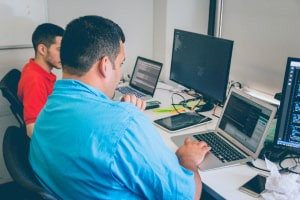Can a microcontroller perform tasks like calculating the logarithm or exponent of numbers? In the introductory section of this course, you will learn how this is possible by reading information from the outside world, processing it with a more complex mathematical operation, and seeing the result of those operations using the MSP430 microcontroller. Then, study how to create a mechanism where multiple activities occur in the microcontroller and deal with it through multiplexing and interrupts. Next, we will introduce you to sequential programming, where the final values of the variables in a program depend on the order you execute the statements. After that, we will discuss planning and implementing an electronics project. Electronics today use embedded computers, and although it uses programming, it also requires a body. This section will prepare you for all the aspects to consider when building an electronic project. While this is about building electronic projects, one should see it in a larger planning context to create an entire project. So, you will observe all the required issues when thinking of building an electronic project.
The course will take you through the "ten commandments" of building an electronics project. First and foremost are the requirements, aims, objectives, and deliveries of the project you intend to embark on. Then you will learn visualization, followed by the schematic, circuit fabrication, power supply, circuit soldering, system wiring after soldering, testing, enclosures, and finally, the documentation of the entire project. Next, examine the circuit prototyping methods and the four types of circuit prototyping methods: the breadboard, zeroboard, manhattan style, and the custom printed circuit board. We will highlight their strengths, weaknesses, and respective prototyping tools. After that, we explain the ten steps involved in cutting and preparing a custom PCB fabrication using the toner transfer method, which is the fastest way of making custom PCBs. Explore one of the three ways of implementing embedded computers, which is single-purpose computers. Finally, you will discover the finite state machine (FSM), a computational model machine used to create sequences, the two types3t, Moore and Mealy machine, and the VHDL Code system.
The final section of the course will discuss the datapath, which represents all the functional elements that process data under the control of FSMs. We will analyze the relationship between FSMs and datapath and the datapath elements. You will then incorporate those ideas into a single-purpose computer that will play a dual dice game. You will be taught how to write the requirements, problem statements, and the elements of datapath and states required in the finite state machine of the game. We will introduce the programmable logic devices of two types; the complex programmable logic device (CPLD) and the field programmable gate array (FPGA). We will show you how to plan, test, and implement an electronics project to create a wirelessly powered art installation using an MSP430 microcontroller. Become skilful in the wireless power transfer methods and the microcontroller circuits used for the project. Learning how to build an electronics project and demonstrating it from its concept to its realization will empower you to build a complete system project using the embedded systems. So why wait? Start learning today!
What You Will Learn In This Free Course
View All Learning Outcomes View Less All Alison courses are free to enrol, study, and complete. To successfully complete this Certificate course and become an Alison Graduate, you need to achieve 80% or higher in each course assessment.
Once you have completed this Certificate course, you have the option to acquire an official Certificate, which is a great way to share your achievement with the world.
Your Alison certificate is:
- Ideal for sharing with potential employers.
- Great for your CV, professional social media profiles, and job applications.
- An indication of your commitment to continuously learn, upskill, and achieve high results.
- An incentive for you to continue empowering yourself through lifelong learning.
Alison offers 2 types of Certificate for completed Certificate courses:
- Digital Certificate: a downloadable Certificate in PDF format immediately available to you when you complete your purchase.
- Physical Certificate: a physical version of your officially branded and security-marked Certificate
All Certificate are available to purchase through the Alison Shop. For more information on purchasing Alison Certificate, please visit our FAQs. If you decide not to purchase your Alison Certificate, you can still demonstrate your achievement by sharing your Learner Record or Learner Achievement Verification, both of which are accessible from your Account Settings.











 Avg. Hours
Avg. Hours  Contains Video
Contains Video  CPD Accredited
CPD Accredited 
 Total XP:
Total XP: 
 Knowledge & Skills You Will Learn
Knowledge & Skills You Will Learn 







